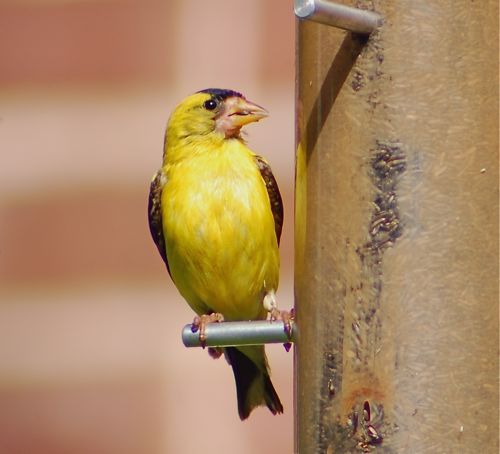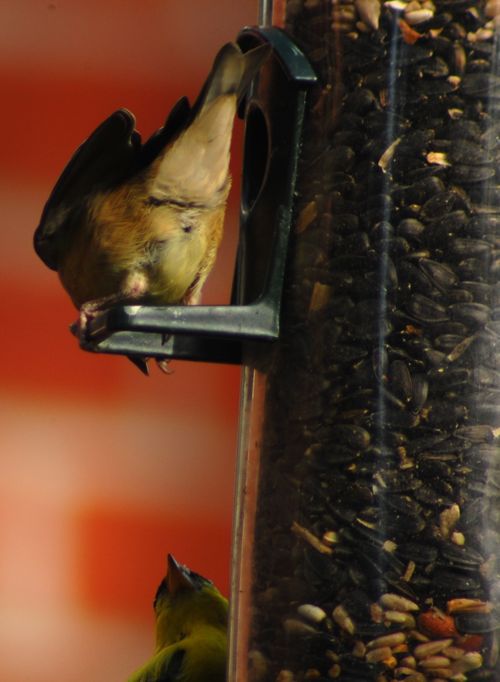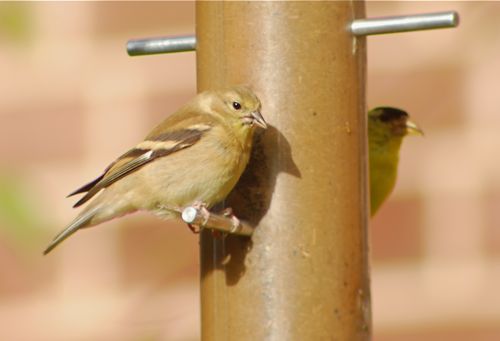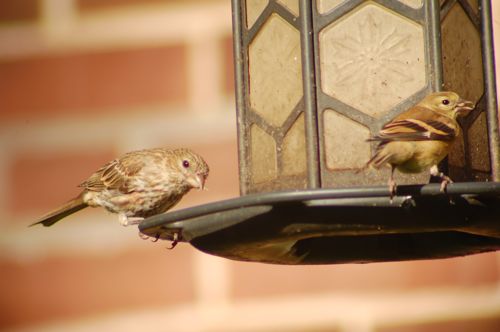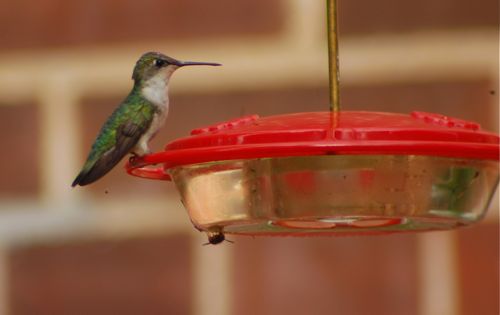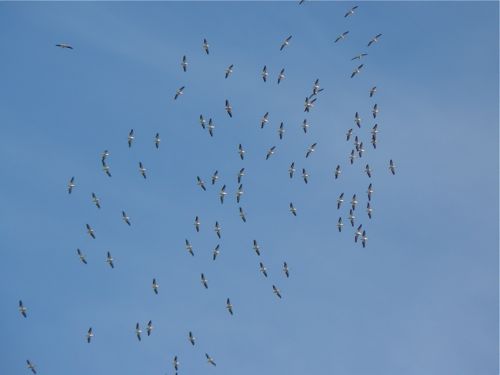Jan Dunlap who wrote the Boreal Owl Murder has a second book coming out in the Bob White mystery series called Murder On Warbler Weekend. Turns out that there is a book release party at Once Upon A Crime book store on Lyndale Avenue South and 26th Street in Minneapolis at 7pm on September 10. There will be refreshments and quite possibly wine so it sounds like a perfect impromtu Birds and Beers. Afterwards, there are several bars in the area to carry on the festivities. So, let's meet up at 7pm on September 10 and support local author writing bird murder mysteries. Half the fun is trying to figure out which Minnesota birders she's killing off.
Young Finches Learning The Ropes At The Feeders
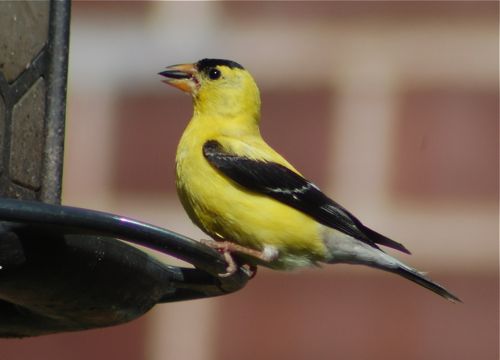 As signs of fall migration make themselves achingly apparent, many of the goldfinches in my area are still holding on strong to breeding plumage. As I was digiscoping this male yesterday, I noticed differences in the bird calls around me. No indigo bunting singing on territory or red-eyed vireo--that was first this month. There were contact calls of warblers. I did hear a scarlet tanager giving the old "chick-burr" behind me and noted that while the tanager was here, all the orioles were gone. I know most people in my neck of the woods have lamented our cold summer. Wearing a jacket in August is crazy, even by Minnesota standards, but I have loved it. Although, as much as I enjoy cool nights and several days without turning on the air conditioner, I look at all my friends who cannot get a tomato to turn red in their gardens this summer and wonder how this affects the seed crops and insects fall migrants need to head south. I also wonder if this means an exceptionally long winter as well.
As signs of fall migration make themselves achingly apparent, many of the goldfinches in my area are still holding on strong to breeding plumage. As I was digiscoping this male yesterday, I noticed differences in the bird calls around me. No indigo bunting singing on territory or red-eyed vireo--that was first this month. There were contact calls of warblers. I did hear a scarlet tanager giving the old "chick-burr" behind me and noted that while the tanager was here, all the orioles were gone. I know most people in my neck of the woods have lamented our cold summer. Wearing a jacket in August is crazy, even by Minnesota standards, but I have loved it. Although, as much as I enjoy cool nights and several days without turning on the air conditioner, I look at all my friends who cannot get a tomato to turn red in their gardens this summer and wonder how this affects the seed crops and insects fall migrants need to head south. I also wonder if this means an exceptionally long winter as well.
I did notice this male goldfinch on the long tube with kind of a reverse goatee. He's bald around his beak. I seem to recall seeing this before in a goldfinch either last year or two years ago. I wonder if it's an odd molt or some sort of mites (not unlike the bald cardinals we see this time of year). This particular male had at least one recently fledged chick following him around to the feeders begging to be fed.
The adult male is on the bottom of the sunflower tube feeder and the begging chick is on the upper perch. The adult would dutifully demonstrate how to get seed out of the port, while the younger bird above continued to beg. Eventually, the young bird left the adult alone and tried pecking around the feeder. It ignored the gaping opening of the feeding port, and pecked at the plexiglass tube. It could see the seed and couldn't understand why it couldn't get at the food.
Eventually, the adult male flew to a different feeder and what does the young finch do? Continue to ignore the open port with food and hang upside down towards where the adult had been feeding and unsuccessfully pecking at the tube around the port. Not the brightest bulb on the tree.
The young finch followed the adult male over to the Nyjer feeder and begrudgingly began to eat the seed out of that port. All the while, continuing to flutter its wings in a food begging behavior.
The young bird finally left the Nyjer feeder and flew over to a black oil sunflower feeder. Soon afterwards, it was joined by a young house finch (who had just a hint of pink show up along his flanks). Both birds fed in peace, but periodically the larger house finch would lunge toward the goldfinch if it got too close. I wonder if these will be the last of the fledglings I will see for the year?
Bees and Edible Fungus
 Look at all the little white bee necks! Cute! I love it when you see bees craning their heads.
Look at all the little white bee necks! Cute! I love it when you see bees craning their heads.
Lorraine and I checked the hives on Wednesday and most is going very well. The yellow Hannah hive and the green Wendy hive are still working their honey supers. We removed the bell jar from the Wendy hive, the bees weren't really building in it and we also noticed that the honey right cells right below the bell jar was not capped. Groundskeeper Hans check the hives last weekend and thought he saw condensation inside the jar too. I decided to remove it, fearing that the recent heat and humidity was affecting the hive.
The red Juliet hive appears to have swarmed. It was quieter in the front and there did not seem to be as many workers in the hive. We took out a frame and found some in progress queen cells...and now I just noticed an egg in that empty cell on the left, maybe she hasn't swarmed yet? This hive is behaving very much like our very first Kitty hive. I remember Kitty was a little behind and still had some space in her hive, but still went into swarm mode. The red Juliet hive had plenty of room, I added a third brood box early and both the middle and top boxes were not completely filled and this hive apparently still feels crowded and swarming is a good idea. I'm concerned about this hive filling out her box enough for winter, but not so much about the swarm.
If she wants to swarm, I'm not going to stop her. We have set up an empty hive in our bee yard in the hopes that a swarm will move in, but that's has far as I want to go. Bees do what they want to do sometimes.
After the bee inspection, I went around to take photos. I was just about to leave when I thought that it's been kind of humid, I should check the oak for sulphur shelf. Alas, no sulphur shelf and I thought, "I should check the other oak for Hen of the Woods, but it seems early." I almost turned around to leave but thought that I walked that far, I might as well check.
Boy, am I glad I did! I found Hen of the Woods! A whole month earlier than I normally do thanks to our very cool summer weather--this is my FAVORITE edible mushroom. I ran back to the house grabbed Lorraine and Groundskeeper Hans to show them. As I was harvesting the tasty edible fungus, I marveled at how we almost missed it and found some start up of more Hen of the Woods next to this large clump, so hopefully more will come. This was a bit older than what I normally harvest, but I was able to get all the bugs out before I froze it.
This wood frog hopped out of the clump as I cut off the brackets. I'm sure it was after all the bugs crawling around it. I left some behind in the hopes that spores would grow more fungus and so the frog could have some bugs since I disturbed his bug buffet.
Chickadee At The Hummingbird Feeder
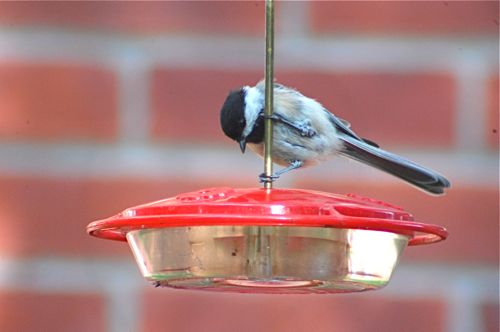 For some reason this black-capped chickadee kept flying down to the hummingbird feeder today. I don't think it was after the nectar. Unusual visitors like house finches, verdins, woodpeckers and even fruit bats are known to partake of the nectar, but I think this chickadee was going for either the water in the ant moat or insects hanging around.
For some reason this black-capped chickadee kept flying down to the hummingbird feeder today. I don't think it was after the nectar. Unusual visitors like house finches, verdins, woodpeckers and even fruit bats are known to partake of the nectar, but I think this chickadee was going for either the water in the ant moat or insects hanging around.
The ruby-throated hummingbirds were not happy about it. It was funny to see a hummer zoom in right after it and then hear the chickadee sputter in irritation.
Birding Private Property While In Las Vegas
 Again, when I said I was going to Las Vegas to see birds, many thought I was a bit crazy. A few thought that I would just see the birds at the casinos like the flamingos above who reside at...The Flamingo. There were also hooded mergansers, shovelers, pochards (which I've actually seen in their native Asia), wood ducks and sacred ibis. But I was into more.
Again, when I said I was going to Las Vegas to see birds, many thought I was a bit crazy. A few thought that I would just see the birds at the casinos like the flamingos above who reside at...The Flamingo. There were also hooded mergansers, shovelers, pochards (which I've actually seen in their native Asia), wood ducks and sacred ibis. But I was into more.
Rita, our contact with Red Rock Audubon said that she knew a great place for hummingbirds, but it was on private property and she needed to get permission to escort us there. It was a lovely yard with a feeding station for hummingbirds and many seed eating species. The home was in the mountains, about 50 miles from downtown Vegas and so worth the trip, it wasn't too far from Spring Mountains National Recreation Area. The morning temperatures were lovely. The only downside was one REALLY pesky honeybee. That bothered all of us and was very interested in my scope and some of my camera equipment. I must have some honey/wax/propolis residue from my hives and this girl was looking to rob.
This was one busy place for hummingbirds. I'm only going to id the in focus rufous hummingbird, those western hummers are a bit tricky for me where I live in the land of mono-species hummingbird. The birds were zipping all over the place, Amy Hooper almost got totally beaned by one and another flew right between the legs of my tripod.
I had to get some help from hummingbird maven Sheri Williamson for this bird's id. She called it a juvenile black-chinned male hummingbird. Speaking of Sheri and black-chinned hummers, she had quite the big news this summer. Some hummingbird banders got a recapture in their nets this summer, only the bird was not orginally banded by them, but was banded by Sheri...in 2000! Nine years ago! That's geriatric by hummingbird standards which are believed to have an average lifespan of three years. You can read the full story here.
Sheri also helped me id this little dude, a broad-tailed hummingbird. How fun to have three different species flying around. Depending on what you read about Nevada, more species are possible.
But hummingbirds weren't the only attraction, there were also Stellar's jays--I love these guys, they almost make the blue jays I see down right drab (almost). The appeared to be a younger jay going through a bit of a molt, but check out the snazzy white eyebrow. You might also notice the white stripe going up from the bill. This is a variation in plumage known as the "interior west." Like many jays, the Stellar's were all happy to hop down and grab a peanut in the shell.
This is a young black-headed grosbeak that flew in for black-oil sunflower seeds and suet.
There were also oodles of finches. Above is a pine siskin on the left. The larger obscured bird in the back is a Cassin's finch. I saw those in Utah, but did not grasp how large they were for a finch. Especially compared to the siskins and goldfinches around.
There were quite a few lesser goldfinches (note the dude with the cap on the right). They were eating black-oil sunflower seed, Nyjer and some sort of finch mix. They were almost as abundant as the hummingbirds.
The lesser goldfinches also ate some of the leaves on the trees too. I wonder if that's a tactic to get moisture?
A big unexpected surprise and probably the best new bird I got on this trip was the finch in the above photo in the middle with the yellow on the wings--a Lawrence's goldfinch! I told Non Birding Bill that for a non birder, he was getting some amazing birds on this trip. He simply gave a non committal, "Oh."
This bird is on Audubon's "watch list" and according to their website its breeding range "is confined to the Central Valley and coastal foothills of California, as well as the northern portion of Baja California." Was excited to get one in Vegas. Rita our guide said that there is usually one that will show up in Nevada when they disperse after breeding season, but did not expect that morning. What a treat!
We were also treated to the uber cute mountain chickadee coming in for sunflower. There was a pygmy nuthatch that popped in and out around the chickadee, but it refused to be digiscoped.
This a GREAT spot and you have to contact Red Rock Audubon to see if you can get permission to visit this yard. The home owners are gracious to allow birders to look at their great feeding station but it's best to make sure to keep the neighbors happy. If you do get the chance to visit, you might consider bringing either a bag of table sugar (for hummingbird nectar) or a back of black-oil sunflower or Nyjer as a thank you for the hosts' birding hospitality.
Big Surprise, Snowy Owls Are Not Good Pets!
It's illegal to keep a native North American owl as a pet in the United States...but not across the pond. Birds of prey do not make good pets. You can use some birds of prey with the proper licensing as a hunting partner for falconry, but that type of bird always stays wild and can fend for itself. Birds of prey kept as pets are doomed. When you keep a young bird as a pet, it "imprints" on what is feeding it. It grows into an adult and learns, "This is what I am. When I grow up, I will look for this shape as not only a source of food, but also a mate...but not all of them, some I'll keep out of my territory."
Oh sure an owl is cute as a small puff ball, but once they reach sexual maturity, they either want to mate with you or drive you out of their territory--both involve that bird flying at your head. Plus, we can't train them to hunt. Humans do not know how to fly around, find prey in low light by sound and then kill it by squeezing it with our toes. That is something that young owls need to learn, sure they have some innate idea to use talons, but at the end of the day, you can't just put an imprinted owl outside and expect it to automatically know how to survive.
Well, like any popular series, people saw owls delivering the mail in the Harry Potter books and movies (and saw female Hedwig played by a very male snowy owl in the movies). Well, people have been buying owls in the UK and have found out, "Wow, these really make awful pets!" As a result, a sanctuary has opened up to deal with all of the imprinted owls:
From the Telegraph:
The Potter phenomenon has been blamed for a surge in the number of people buying owls, emulating the young magician who keeps a snowy owl called Hedwig as a pet. Now an animal sanctuary has opened on the Isle of Wight to help cope with the problem of owls dumped by owners who can no-longer care for them properly.
Animal expert Don Walser, who has opened Newport Owl and Monkey Sanctuary, said: "The problem is that no licence is required, anyone can buy an owl.
"They might look great in the Harry Potter films, but it takes years to train them. Children read the books and see the films and say to their mums and dads they want one and parents don't realise how much care it takes to look after them.
"We have got about 20 owls at the moment, which have come from all over the country.
"I have a pair of snowy owls that were left in a garden by their owners for three days without food. They would have died. It was disgusting.
"Some people keep them in appalling conditions," said Mr Walser.
RSPCA spokeswoman Jo Barr said the Potter stories led to a big rise in enquiries about owls from the public.
"In the past years we have seen an increase in the number of Dalmatians sold after the Disney films and we also saw an increase in the number of turtles after the Ninja Turtles craze.
"We saw a noticeable increase in calls from people wanting to know where they could obtain an owl following the release of the first Harry Potter film," she said.
She said the RSPCA advises that people do not buy owls as pets, which need a lot of care and can live for 20 years. Although it is illegal to sell wild birds, traders can deal in captive bred specimens, with breeds like snowy owls fetching around £250 a bird.
Migration Is On!
I'm so excited about all the people who are coming to the Midwest Birding Symposium! I can't believe it's coming up in mere weeks. Who cares about the birds, this is going to be the chance to meet so many birders from so many different places. I noticed that David Sibley has been added as a speaker to the MBS but also noticed today that he's coming to the Twin Cities in early October for the RainTaxi Book Fest. I stumbled upon this by accident, it will be interesting to see if the festival advertises this to the birding community or if they are going to focus on just his new Tree Guide.
I've been trying not to notice migration under way. I'm working on three big projects and wanted one finished before migration, but today I saw that is clearly not going to happen. It started with two large flocks of pelicans over the Science Museum in downtown St. Paul. I tried to tell myself, "Oh, it's just practice, it's not happening yet."
Then, one of my fellow park rangers, Ranger Brian brought by a dead warbler to confirm its identification. He had picked it up on his morning route for checking for birds that die from window collisions during night migrationts...it's time already??
Then Woodcreeper (which is a FABULOUS migration site) shared this Nexrad photo on Twitter showing the bird migration going on tonight on the eastern half of the US. If you are on the east coast and reading this tonight, keep an ear outside, you might hear the faint chips of night migrants.
I cannot deny it anymore...migration is on.
Get Your Woodcock On!
[youtube]http://www.youtube.com/watch?v=EdYjVSMoWhw[/youtube] No one is 100% why woodcocks move this way when foraging, the guess is that it is causing worms to move in the soil, making it easier for the woodcock to find them.
Roadrunner vs Cowbird At Spring Mountain Ranch State Park
 I need to get back to Spring Mountain Ranch State Park in Nevada. I blogged earlier that I given the advice by the Red Rock Audubon Society to visit here, since there would be different species than we would see in and around Las Vegas. We saw some great birds and I got a life bird, but I also saw one of the coolest birding interactions I have ever seen.
I need to get back to Spring Mountain Ranch State Park in Nevada. I blogged earlier that I given the advice by the Red Rock Audubon Society to visit here, since there would be different species than we would see in and around Las Vegas. We saw some great birds and I got a life bird, but I also saw one of the coolest birding interactions I have ever seen.
It started when we reached the actual ranch part of the park. That's Clay and Non Birding Bill setting up their cameras. Clay spotted a predator in the grass:
Can you see it? Believe it or not, there is a greater roadrunner lurking in that grass. Clay gets them in his backyard in Corpus Christi. Roadrunners are incredible predators that will eat snakes, reptiles and even birds. In Clay's yard, the roadrunner stalks house sparrows. He recognized this bird as being on the hunt right away. Most of my experiences with roadrunners has been watching them scurry along a road, so to watch it in full on skulk mode for the hunt was incredible.
The roadrunner would crouch down in the tall grass and slink along with just the top of its head visible. Almost like a feathered shark fin breaking the top of an ocean. Periodically, it was stop for an insect and gulp it down while using the grass for cover. What was this bird stalking for a meal?
A flock of unsuspecting cowbirds. They were following the cow and the horses in the field. The area was recently grazed and the grass was short for the cowbirds to feed, but nearby the taller grass hid a predator actively stalking them. Clay, Bill and I all staked out a position to get photos of whatever was about to happen.
One lone cowbird made the fatal error of straying away from the safety of the flock. I tried to line this shot up so that the cowbird was in front of the roadrunner, but the roadrunner had crouched so low, you couldn't see it. Suddenly, the cowbirds took flight, some went right over the roadrunner. The predator leaped into the air, grabbed a cowbird with it's beak, whacked it a few times against the ground, and took off running. NBB actually got footage of that, which you will see when we get the videos edited together.
I got a shot of the roadrunner crossing the road in front of us with the dead cowbird in its mouth. I previewed this photo on Twitter with the question, "Guess what's in the roadrunner's mouth?" A few were insistent that it was a house sparrow, but this is a young cowbird--note the size in relation to the roadrunner, the white throat patch, the thick dark bill, and the vertical streaks on the breast (young cowbirds have vertical streaks). House sparrows and brown-headed cowbirds are unpopular birds. House sparrows are an introduced species that can wreak havoc on nesting bluebirds, chickadees and nuthatches. Brown-headed cowbirds are natives, but their nesting habit of laying their eggs in other birds nests has caused problems for species like Kirtland's warblers. Many people don't mind a roadrunner eating those particular species. But like any successful predator, roadrunners are generalists. They don't go for just he unpopular birds, many in the western US are chagrined to find roadrunners stalking their hummingbirds feeders.
As we worked our way around the trails, we made it to Lake Harriet, which was an oasis of color. Above is WildBird on the Fly scanning the water for ducks. It was quiet apart from some young coots incessantly clucking. I think this would be packed on a weekend, but on a week day this was a spot where you could imagine being the only person for miles.
It was weird having NBB along on this trip (my birding and non birding world was colliding, my compartments were getting mixed up). I sat at this spot and leaned against NBB for a moment. I'm so used to seeing a beautiful vista and wishing he were next to me or wondering what he'd be doing while I'm and about, it was a treat to have him there to see this with me. My filmmaker husband did surprisingly well on this trip. I must admit that I was nervous with how we would handle being around my birding friends for 5 days and out doing some hardcore watching and filming in the heat. But I think since he was focused on getting footage, he was able to do it. I'm so proud, he got some great footage--especially that roadrunner. Editing is going to take longer than I thought, but this video series is going to be so cool, it's about how you can watch birds anywhere and we're using a small HD camera while Clay experimented with a cheaper hand held video camera with the new Swarovksi UCA adaptor and I took video with my Cannon A570's point and shoot video feature and my scope. On the fly birding videos for the internet, I love making these.
This little lake was chock full of young coots. They don't quite look like the black adults, but when this young bird stepped out of the water, those lobed toes gave it away as a total American coot. Again, I wish we could have explored further, there's an old cemetery in the park and it would have been fun to visit that too. This park was a great suggestion from Red Rock Audubon.
We saw signs around the park that wild burros were possible and as we were packing up to leave NBB said, "Look, burros."
There they were! Wild burrows...well feral burros...oh heck, we all shouted, "Wild Asses!"
Just what we came to Vegas for!
These are feral burros, they were brought over as a beast of burden by the Spanish because they do well in arid climates. The ones that roam the west are the result of escapees or released animals from well over a century ago. They behaved pretty much the way a captive burro would behave and I'm not sure why I got so excited over seeing feral ones. What is it about seeing an unfettered ass that makes me so happy?
So, this is a very cool park and if you have some time in Vegas, check it out. You could easily spend a full day here, but we did it in half a day. It was easy to get in and get out with a rental car. If you don't have a rental car, if you contact Red Rock Audubon Society, you could probably find a guide to take you there for a reasonable fee.
I'm going to end this with some video of the cowbirds. Note how they keep their tails cocked up while they feed. I wonder if they are releasing heat from their vent area as a means to keep cool?
[youtube]http://www.youtube.com/watch?v=hiX_fIBU0js[/youtube]
Weird Day Yesterday
It rained almost all day yesterday. I was enjoying the sound of water on pavement and getting some writing accomplished when I heard the tornado sirens. It was in the sixites, it was light out, no wind, no thunder, just a gentle rain. I immediately assumed the sirens were the monthly test, but realized it was not the first Wednesday of the month and a look at the clock showed that it was not noon, but 2:24 pm. I turned on the tv to see what was going down and come to find out that there was a tornado, a few blocks from our building that went right into downtown Minneapolis. Non Birding Bill works where it hit, but he works in a basement of a university so was safe all along. The tornado was well past by the time the sirens went off, but someone got a phone photo of it off the freeway near where we live.
Fortunately, no one was seriously injured, but there are quite a few uprooted trees and broken windows. I've grew up in Indiana, I know the signs for a tornado and this particular storm really surprised me. It wasn't green outside, it wasn't that dark out, no hail, no wind in my neighborhood, and it was relatively cool outside for a tornado. All we had was a gentle rain.

